Edelrid has long been a leader in the sustainability of climbing products. Over the past few years, the company has released ropes and soft goods made of upcycled and recycled materials. And Edelrid has long championed longer-lasting metals in hardware. The German brand has now released enough gear made of recycled materials to be outfitted from head to toe for a day at the crag.
Edelrid’s History in Sustainable Climbing Gear
We’ve featured Edelrid rock climbing products with a strong sustainability component. My first exposure to the brand’s sustainability efforts was through the venerable Mega Jul braking-assisted belay device, which was released in 2015. Edelrid’s approach to braking assistance was the simplest of the bunch, but it was effective.
Edelrid makes the Jul in several iterations, and I’ve used several of them for sport climbing, mountaineering, multipitch adventure climbing, and ice climbing. The sustainability aspect of these belay devices is that they are made of steel. It lasts much longer than aluminum under constant rope abrasion.
Edelrid repeated using steel to extend life under rope wear in their Bulletproof line of carabiners. From quickdraws to belay carabiners, Edelrid cleverly installs a steel wear plate where the rope runs.
The Edelrid Bulletproof is my quickdraw of choice for sport climbing. My collection has shown no wear at the rope end, whereas all-aluminum ones can show wear after one season. The same goes for the HMS Bulletproof Triple FG belay carabiner that I use for all roped rock climbing.
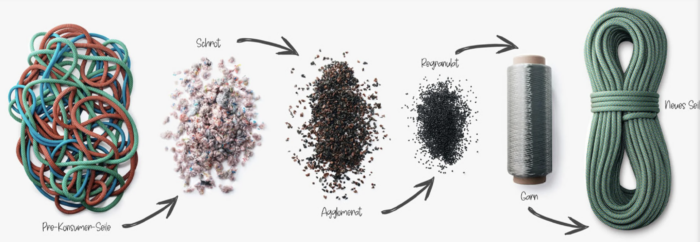
Edelrid launched its BOA Eco 9.8 rope in 2016, which upcycled yarns leftover from new rope production. Last year, after 6 years of research and 2 years of development, Edelrid cracked the code for making new ropes out of recycled ones. With the Edelrid Neo 3R 9.8 release, Edelrid successfully launched the world’s first dynamic climbing rope made of 50% reused ropes.
And here we are at the next step. For the first time in my nearly 35 years of climbing, I went to the cliff sporting recycled and upcycled gear. This included my rope, shoes, harness, slings, and helmet. What a glorious day and development for the sport I hold dearest.
Here’s a rundown of the recycled components of the Edelrid 3R recycled cragging kit. The brand uses 3R nomenclature to highlight its many products that Reduce, Reuse, and Recycle materials. The third “R” represents recycled content.
Edelrid Zodiac 3R: First Part-Recycled Climbing Helmet
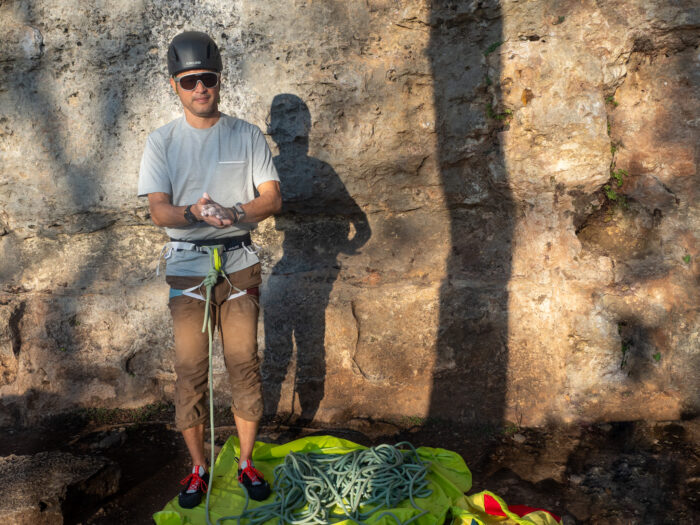
This subtitle says it all on the sustainability front. Edelrid invented the modern Kernmantle climbing rope, the first dynamic rope with 50% reused ropes. So, a helmet with pre-consumer recycled components follows suit.
The hard outer shell is made of 100% recycled materials from ropes. And the EPS energy-absorbing liner is also made of 100% recycled content.
The helmet fit my oval-ish head adequately. It was a little tight in the fore-aft dimension but not at all uncomfortable. It would fit climbers with round heads better.
The dial-adjust retention system on the one-size-fits-all lid snugged it up to whatever tension I desired. I felt the ventilation was on par with other hard-shell-type helmets. But I feared the all-black, the only color option, would be hot in the Texas or Mexico sun.
At a verified weight of 12.8 ounces, the Edelrid Zodiac 3R is certainly heavier than the “soft shell” type of climbing helmets (the new Black Diamond Vapor in M/L is astonishingly half that). But if you prefer a more robust hard-shell type, the recycled content of this helmet makes it awfully attractive. And the $70 MSRP is reasonable.
Edelrid Moe 3R Harness: The First Part-Recycled Harness
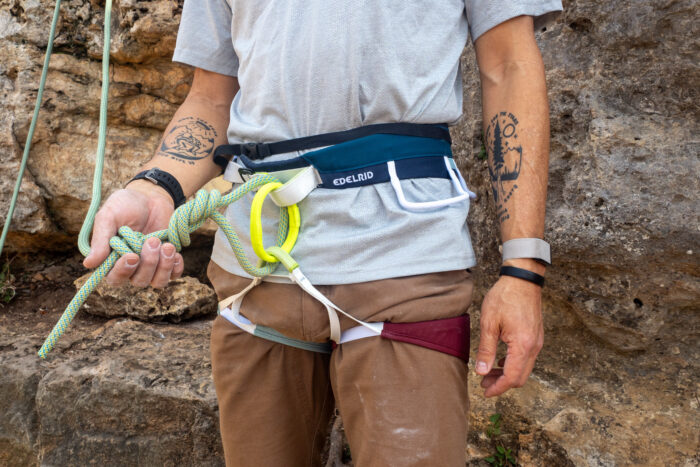
Adding to Edelrid’s firsts in climbing sustainability, the Moe 3R is almost completely made from recycled polyester. This makes it the first harness to claim the title of being made of recycled content.
Edelrid tags the Moe 3R as an all-around harness and outfits it appropriately. Large gear loops accommodated trad hardware, and there is an ice-clipper attachment point. The waist flares out to 3 inches at its widest, feeling supportive without being restrictive during gymnastic contortions on my area’s short, bouldery routes.
I have a 32-inch waist, weigh 168 pounds, and have bigger thighs than the typical high-end sport climber. The fit around my thighs was snug but not at all constricting. The waist circumference was also correct. I fell into the smaller end of the adjustment range, but the belay loop was centered.
The harness fabric is recycled and shared with the apparel brand Vaude. Other components like metal buckles, bar tack yarn, tie-in point protectors, some threads, and leg loop riser straps all have a sustainability component.
I felt the Edelrid Moe 3R was a great, midlevel harness for the multidiscipline climber who only wants one model. The Moe 3R hit the sweet spot between being supportive and reasonably light (my medium has a verified weight of 11 ounces). The recycled and sustainability aspects are bonuses, as is the modest $70 price tag.
Edelrid Neo 3R 9.8 Climbing Rope
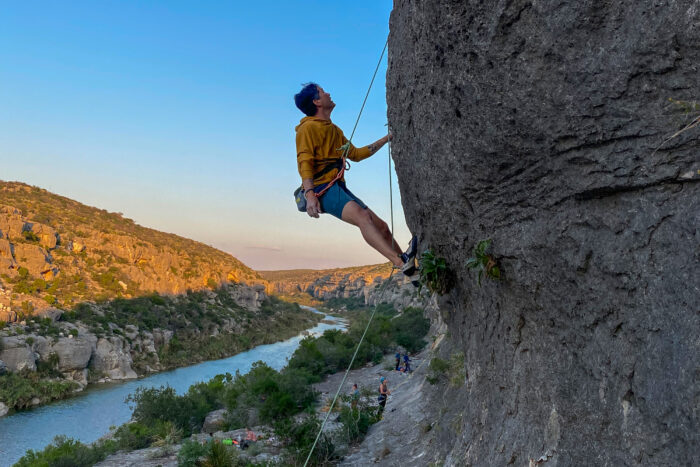
We tested and reviewed the Edelrid Neo 3R rope last year and were happy to report that it did what a high-quality climbing rope should do and did it well. Edelrid using 50% recycled content from discarded ropes was a well-received bonus. The 70m version of the Neo 3R carries an MSRP of $250.
Edelrid PES 3R 16mm Sling
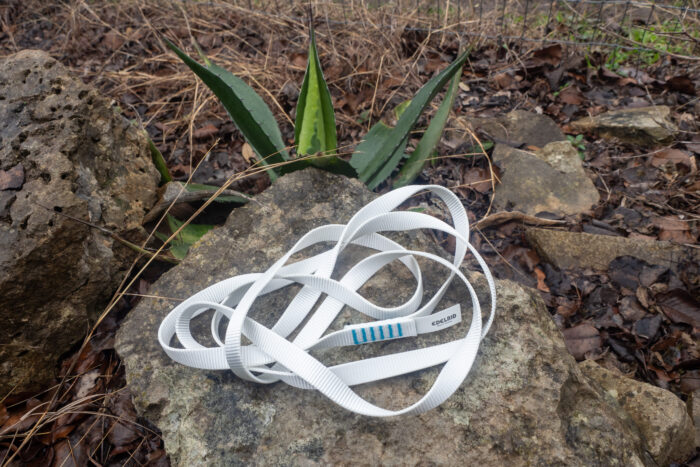
Similar to the rope bag, it’s hard to say anything about a sling other than it worked. But the 120cm, 3.5-ounce Edelrid PES 3R 16mm sling can boast a few things that set it apart.
Firstly, it’s made of recycled polyester. Secondly, red fibers inside indicate critical wear, signaling that it’s time to retire the sling. Both of these bonuses are unique twists on a climbing staple. Edelrid sells the 120cm PES 3R 16mm sling for $11 (also available in 60cm for $8).
Red Chili Ventric Air Lace: First Rock Shoe Made of Recycled Materials
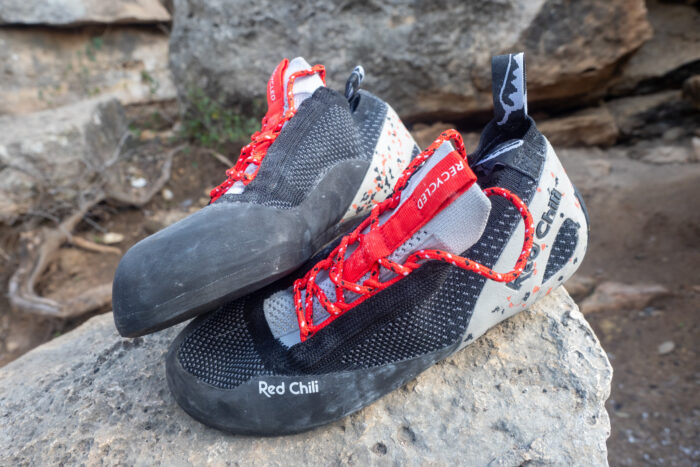
Edelrid owns Red Chili, and the rock shoe brand claims the following regarding its Ventric Air Lace climbing shoe: “All of the textile elements of the upper material, i.e., the fabric, laces, lace loops, and even the pull-on loops, are recycled from post-consumer polyester and produced in line with the Global Recycled Standard (GRS).”
This significant first pairs well with the comfortable, all-day performance the shoe delivered. The flat profile, straight last, and woven, breathable upper kept my feet from complaining when I kept them on for long periods. The Ventric Air Lace kept my feet cooler than any other climbing shoe I’ve tested to date.
The shoe worked well on the slightly slabbed-out or dead-vertical routes. The 2.0mm RX-2 TECHGRIP adhered adequately well to well-worn limestone and provided moderate feedback.
The Red Chili Ventric Air Lace has attributes that I felt would keep beginners comfortable on easy-to-moderate routes, especially in summer.
My size 42 samples weigh a verified 15.4 ounces per pair and carry an MSRP of $120.
Edelrid Drone Rope Bag
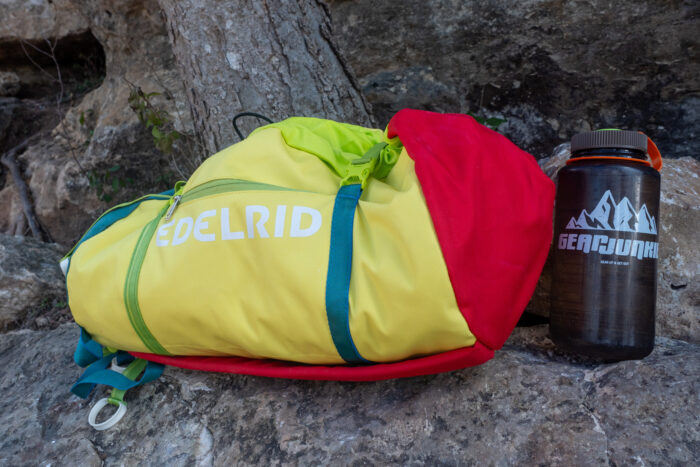
Although not officially part of the Edelrid 3R collection, the German brand makes its Drone Rope Bag out of fabric remnants from other soft goods. The 48″ x 55″ tarp easily accommodated 80m ropes and provided a place to shoe up and keep hardware out of the dirt.
And the generously cut bag left plenty of room for other gear. I could stuff my shoes, chalk bag, and harness inside, in addition to a 70m or 80m cord.
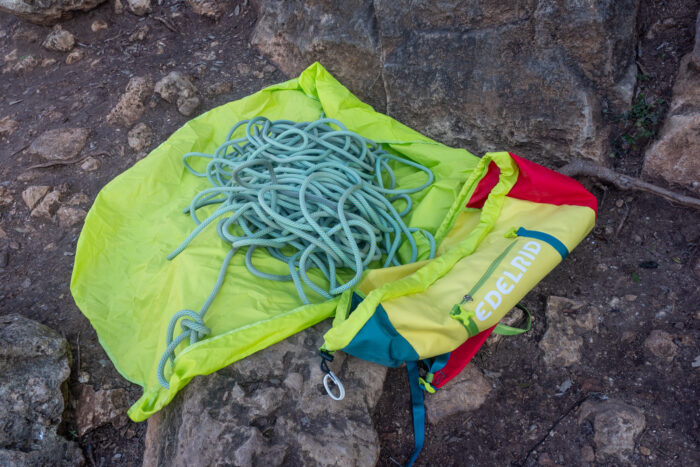
The tarp has four tie-in points and a thoughtful visual partner checklist to reference before leaving the ground. The bag has a zipped outer pocket for smaller items and shoulder straps for a backpack-style carry.
The rope bag and tarp did the job and looked great doing it. Everyone liked that each Edelrid Drone has a unique color scheme due to the random scrap fabric. And it is also very cool that the fabric would have gone into the trash if it had not gone into the 1-pound, 4-ounce, $50 Edelrid Drone Rope Bag.
Conclusions on the Edelrid 3R Sustainable Rock Climbing Collection
As you’ve just read, the Edelrid recycled 3R rock climbing collection performed well, and the prices are modest. Each item allowed me to enjoy my time at the crag without any gear-related issues.
The fact that they contained recycled materials never entered my mind during the day. Each Edelrid 3R item was a welcome addition to my kit, and I have no qualms about recommending them to the appropriate climbers.
The sustainability aspect was an added and welcome bonus. I felt that this was the way for the future, not just for climbing but also for the planet. I hope Edelrid’s sustainability efforts and those of other climbing brands continue to grow. Most climbers are very conscientious of their impacts on their beloved playgrounds, and sustainable, recycled gear makes so much sense.
Bravo, Edelrid. As a lifelong climber and lover of outdoor spaces, I applaud your creation of these recycled climbing gear firsts.








